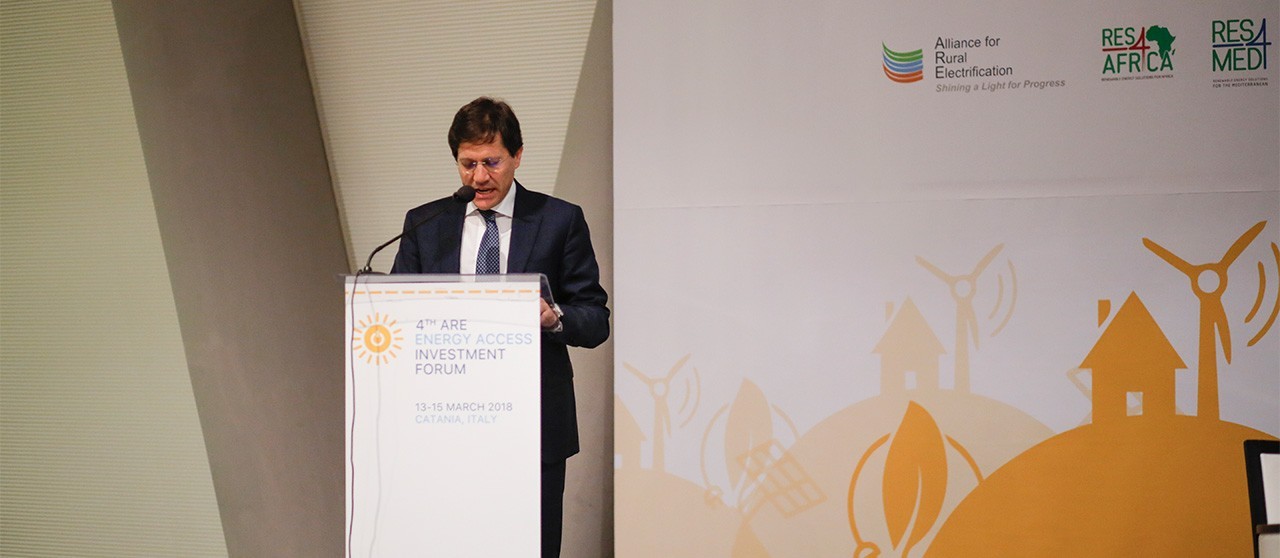Society and indeed life itself would simply be inconceivable without electricity. Yet more than a billion peoplelive without it: that’s twice the population of the European Union. They mainly live on the Indian subcontinent and in Sub-Saharan Africa, and primarily in rural areas. The “electricity gap” is one of the world’s most striking inequalities.
A bridge to Africa
Promoting electrification in rural areas is the aim of the Alliance for Rural Electrification (ARE), which held its fourth Forum from 13 to 15 March in Catania. It was an opportunity to take stock of the situation, redefine objectives and outline new strategies with the participation of more than 200 representatives from institutions, international organisations, industry and NGOs.
The event, for which Enel Green Power was Diamond Sponsor, was organised in partnership with two associations for the development of renewable energy in Africa: Renewable Energy Solutions for Africa(RES4Africa) and the Africa-EU Renewable Energy Cooperation Programme (RECP).
The choice of Catania was intentional. Italy is a natural bridge between Europe and Africa, both geographically and historically, and is home to the RES4Africa headquarters. Sicily, on the other hand, is the real point of contact and is crucial for migration: that’s why RES4 Africa proposed it as the venue for the 2018 edition. And, last but not least, Catania is the city where Enel launched the Innovation Lab in Passo Martino and the 3SUN factory, which now belongs to Enel Green Power. It is the largest photovoltaic panel production plant in Europe: a genuine centre of sustainable innovation.
More – and cleaner – electricity
Electrifying the countryside not only means significantly improving the living conditions of local inhabitants, but also creating new jobs, promoting socio-economic development and, ultimately, helping to bring stability to many areas of the world.
Having explained the “why,” ARE is now moving on to the “how” phase: electricity needs to be brought to rural communities in the most efficient and sustainable way possible, as required by the United Nations sustainable development objectives.
According to the International Energy Agency (IEA), investment in clean energy is increasing significantly. This is also due to falling costs: communities gaining access to electricity between 2017 and 2030 will, in 61% of cases, have it thanks to renewable sources (especially solar and hydroelectric), compared to only 30% between 2000 and 2016.
Yes, but what about the grids?
The most difficult issue is still that of the distribution grids: should we focus on conventional grids or on local microgrids, or even on individual off-grid systems?
As Antonio Cammisecra, Enel Green Power CEO, explained in the opening speech, the answer depends on the local situation and, more specifically, on four parameters relating to the community that is acquiring electricity for the first time: its size, population density, distance from the national electricity grid and electricity demand forecasts.
For urban areas that are still without electricity, the obvious solution is the centralised grid that already serves cities. For rural communities, however, connection is not always feasible: the IEA estimates that it is possible in only 68% of cases.
On the other hand, options such as microgrids powered by plants below 1 MW will be useful, in 11% of cases, and off-grid systems below 150 W will be useful in the remaining 21%. Microgrids are more suitable, for example, in West and Central Africa, while off-grid systems will take the lion’s share in East Africa. And, thanks to technological innovation, there is also a middle ground: a hybrid grid that combines a local microgrid with off-grid systems.





